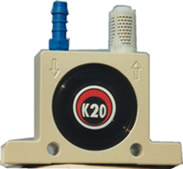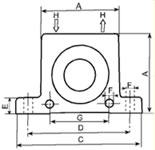

 |
DESCRIPTION Manufactured with a rustproof extruded aluminum body fitted with hardened steel races on which a steel ball rotates. |
| PERFORMANCE DATA | |||||||||
| MODEL | FREQUENCY |
FORCE OUTPUT |
AIR CONSUMPTION |
||||||
30 PSI |
60 PSI |
90 PSI |
30 PSI |
60 PSI |
90 PSI |
30 PSI |
60 PSI |
90 PSI |
|
vpm |
vpm |
vpm |
lbs |
lbs |
lbs |
cfm |
cfm |
cfm |
|
K 8 |
25000 |
31000 |
35000 |
29 |
58 |
81 |
2.9 |
5.1 |
6.9 |
K 10 |
22000 |
28000 |
30000 |
56 |
106 |
160 |
3.2 |
5.3 |
7.1 |
K 13 |
15000 |
18000 |
24000 |
72 |
124 |
196 |
3.3 |
5.6 |
7.9 |
K 16 |
13000 |
17000 |
19000 |
101 |
180 |
248 |
4.3 |
7.1 |
9.9 |
K 20 |
10000 |
14000 |
16000 |
162 |
275 |
387 |
4.6 |
8.1 |
12 |
K 25 |
9000 |
12000 |
14000 |
209 |
353 |
461 |
5.6 |
10.2 |
16 |
K 30 |
8000 |
10000 |
12000 |
340 |
556 |
722 |
7.6 |
13.2 |
20 |
K 36 |
7000 |
9000 |
10000 |
464 |
709 |
911 |
9.2 |
16.8 |
24 |
HOW IT WORKS Series K, which is small in overall size, pneumatic ball vibrators frequency can be regulated by adjusting
|
|
|
 |
||||||||||||||||||||||||||||||||||||||||||||||||||||||||||||||||||||||||||||||||||||||||||||||||||||
TECHNICAL DATA |
|
| Unbalance Weight: | Ball (Type number is diameter in mm) |
| Lubrication : | Not necessary |
| Air Supply : | 30 to 90 PSI |
| Air Type : | Clean, use of filter (40 µm) recommended |
| Body : | Aluminum, stove-enamelled cream-grey |
| End Caps : | black Nylon, self retaining |
| Max Temperature : | 220°F (100°C) |
| Noise Level Range : | 75 to 95 dBA with silencer |
ADDITIONAL TECHNICAL INFORMATION
Air
pressure inlet and exhaust ports have standard pipe threads, allowing
the exhaust air to be piped away,
ensuring that no restriction is
imposed on exhaust air.
The pipe thread is BSP (British Standard Pipe) but will accept the US NPT (National Pipe Thread).
The K indicates the ball series and the number stands for the diameter of the ball in millimeters.
The maximum ambient operating temperature is 100°C (220°F).
The noise level range is 75 to 95 dBA with muffler.
Epoxy paint coating
You
can place the vibrator in any mounting position. The centrifugal force
created
when the air pressure is applied
will cause the ball toimmediately
find its correct path on the race.
NOTE:
If the vibrator is mounted with its rotary axle in a vertical position,
the lower end cap will hold the ball as long as no air pressure is
applied.
As soon as air pressure is applied the ball will rotate on
its races and not move along the end plate any more.
The
ball vibrators can be operated intermittently without losing their
effectiveness or causing other difficulties
since the vibration stops
immediately after pressure is cut. Therefore, it is very useful in
packing machinery industries.
Lubrication
is not required, but only clean (filtered) air should be used because
dirt will cause the ball to jump and
dent the ball's race.